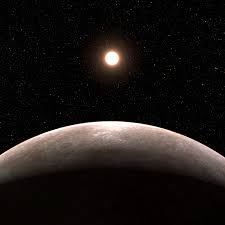Ahmedabad
(Head Office)Address : 506, 3rd EYE THREE (III), Opp. Induben Khakhrawala, Girish Cold Drink Cross Road, CG Road, Navrangpura, Ahmedabad, 380009.
Mobile : 8469231587 / 9586028957
Telephone : 079-40098991
E-mail: dics.upsc@gmail.com

Exoplanet – LHS 475b
News: NASA recently announced that the James Webb Space Telescope has discovered its first new exoplanet.
Background:
• Located just 41 light-years away, the planet orbits very close to a red dwarf star and completes a full orbit in just two days.
• Researchers hope that in the coming years, owing to the Webb telescope’s advanced capabilities, they will be able to detect more Earth-sized planets.
What are Exoplanets?
• Exoplanets are planets that orbit other stars and are beyond our solar system. According to NASA, to date, more than 5,000 exoplanets have been discovered. Scientists believe that there are more planets than stars as each star has at least one planet orbiting it.
• Exoplanets come in a host of different sizes. They can be gas giants bigger than Jupiter or as small and rocky as Earth. They are also known to have different kinds of temperatures — boiling hot to freezing cold.
Why do we study them?
• Studying exoplanets not only broadens our understanding of other solar systems but also helps us piece together information about our own planetary system and origin.
• Another important element of the study is finding out the distance between an exoplanet and its host star. This helps scientists determine if a discovered world is habitable or not.
• If an exoplanet is too close to the star, it might be too hot to sustain liquid water. If it’s too far, it might only have frozen water. When a planet is at a distance that enables it to have liquid water, it is said to be in the “Goldilocks zone”.
How are they discovered?
• Scientists rely on indirect methods, such as the transit method, which is “measuring the dimming of a star that happens to have a planet pass in front of it.”
What are Red dwarf stars?
• The newly discovered exoplanet orbits around a red dwarf star.
• Such types of stars are the most common and smallest in the universe. As they don’t radiate much light, it’s very tough to detect them with the naked eye from Earth. However, as red dwarfs are dimmer than other stars, it is easier to find exoplanets that surround them. Therefore, red dwarfs are a popular target for planet hunting.

Address : 506, 3rd EYE THREE (III), Opp. Induben Khakhrawala, Girish Cold Drink Cross Road, CG Road, Navrangpura, Ahmedabad, 380009.
Mobile : 8469231587 / 9586028957
Telephone : 079-40098991
E-mail: dics.upsc@gmail.com
Address: A-306, The Landmark, Urjanagar-1, Opp. Spicy Street, Kudasan – Por Road, Kudasan, Gandhinagar – 382421
Mobile : 9723832444 / 9723932444
E-mail: dics.gnagar@gmail.com
Address: 2nd Floor, 9 Shivali Society, L&T Circle, opp. Ratri Bazar, Karelibaugh, Vadodara, 390018
Mobile : 9725692037 / 9725692054
E-mail: dics.vadodara@gmail.com
Address: 403, Raj Victoria, Opp. Pal Walkway, Near Galaxy Circle, Pal, Surat-394510
Mobile : 8401031583 / 8401031587
E-mail: dics.surat@gmail.com
Address: 303,305 K 158 Complex Above Magson, Sindhubhavan Road Ahmedabad-380059
Mobile : 9974751177 / 8469231587
E-mail: dicssbr@gmail.com
Address: 57/17, 2nd Floor, Old Rajinder Nagar Market, Bada Bazaar Marg, Delhi-60
Mobile : 9104830862 / 9104830865
E-mail: dics.newdelhi@gmail.com